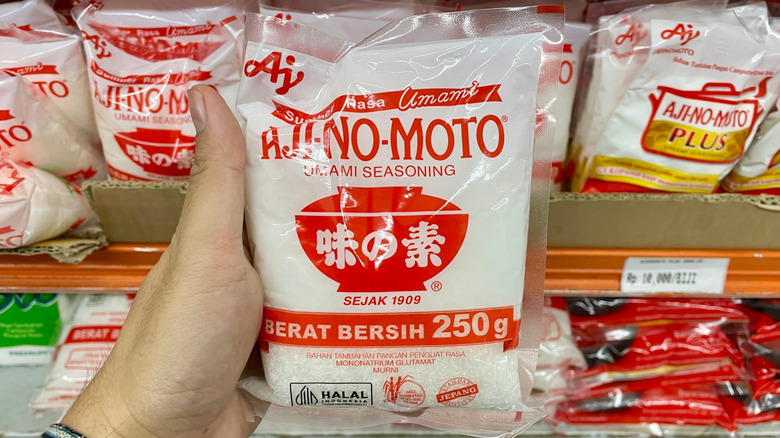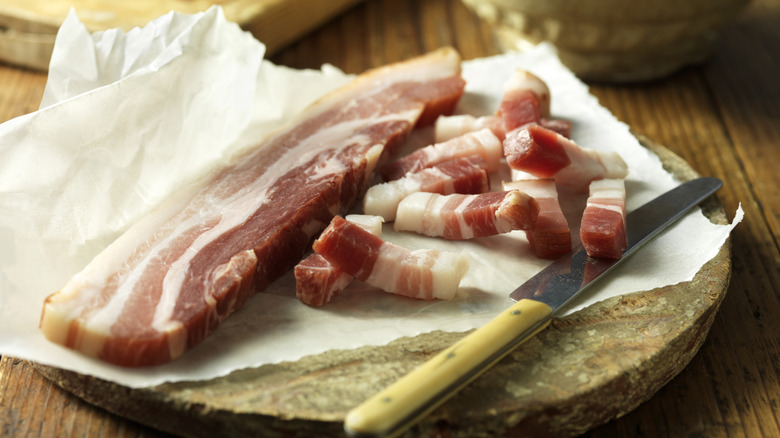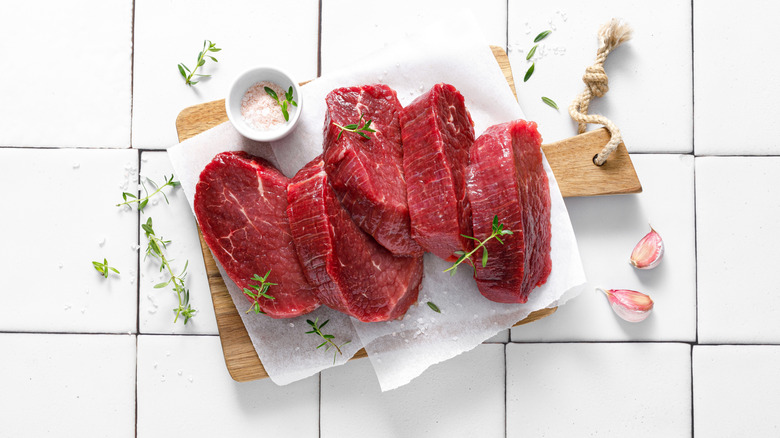12 Ingredients To Add In For Better Beef Stew
We may receive a commission on purchases made from links.
Beef stew is a rustic, classic dish that's been enjoyed in one form or another since ancient times. When you slow-cook meat and vegetables together, you just so happen to end up with a one-pot meal that's incomparably cozy, hearty, and satisfying — perfect for the cold months (and nothing to complain about on hot days, either).
Be honest, though: Your beef stew may be hearty and filling, but is it truly wow-worthy? While meat and veggies are a dependable foundation, relying on them alone to carry this dish's flavor is a common mistake people make when cooking beef stew. If you think this iconic meal has no surprises left in store for you, think again: There's a lot more deliciousness waiting in a bowl of beef stew than you may realize. To learn how to unlock it, Chowhound did a little digging; we asked five culinary experts for ingredient additions and swaps that elevate this dependable standby from "edible" to "incredible."
1. Sauces or pastes containing anchovies add major depth (and no fishiness)
It's possible to amp up the savory, meaty notes of beef stew with the addition of ingredients that provide umami, the "fifth taste," thanks to the amino acid glutamate (glutamic acid). Umami is the essence of savoriness, detectable not only in obvious sources like seared beef but also in foods like tomatoes, soy sauce, egg yolks, and fish. Anchovies, in particular, are known for being rich sources of umami, with 100 grams of these tiny fish containing roughly 630 milligrams of naturally occurring glutamate. Try 1 tablespoon of anchovy paste in beef stew to add a pleasant meaty saltiness. (Ina Garten uses it as her secret ingredient in a tuna melt, but it works with non-seafood dishes as well!)
Marye Audet, best-selling cookbook author and recipe developer at Restless Chipotle, makes use of the umami in fish by always elevating her beef stew with a splash of fish sauce. This doesn't add a fishy flavor, she explains, but rather a richness that increases the stew's depth and provides an overall more succulent flavor.
Audet actually discovered her fish sauce trick when she ran out of another staple flavor-maker, one perhaps sitting in more American pantries right now than fish sauce: Worcestershire sauce. That's right – one of the key components of this classic condiment is fermented anchovies. About 1 teaspoon of it is enough to pop the flavor in beef stew.
2. Amp up flavor with umami-enhancing seasonings
There are other ingredients with umami-enhancing powers that we can't overlook when it comes to making a better beef stew. At the most basic level is salt, which ups umami flavors. (Think about how salting a raw tomato enhances the taste.) There's a wealth of choices beyond salt, though, most notably seasoning blends that contain glutamate sources. Mushrooms are full of umami (more about mushrooms later), and you'll find them in a variety of seasonings like McCormick Umami Seasoning with Mushrooms and Onion, which go great in beef stew.
Then there's straight monosodium glutamate (MSG) itself. Once falsely vilified as the culprit behind a slew of mysterious symptoms brought about by Chinese food, current research puts MSG in the "generally recognized as safe" (GRAS) category by the FDA, the same classification as ingredients like black pepper and vinegar. Added before or during cooking, about ½ teaspoon of MSG can enhance the flavor in your beef stew.
3. Mushrooms increase beef stew's heartiness and flavor
Flavor-enhancing seasonings aren't the only way to bring the succulent umami of mushrooms to your beef stew. Tossing in the fungi themselves can make this rustic dish not only more filling but also more flavorful. Lindsey Baruch, CEO and founder at Lindsey Eats, recommends jazzing up beef stew with baby bella mushrooms for their deep, rich, earthy flavor, especially if you opt to brown them first. In fact, cooking intensifies the flavor of any type of mushroom; they all naturally contain some degree of that savory-enhancing amino acid, glutamate, and the process of removing moisture during roasting causes it to become nice and concentrated.
While baby portobellos are a great choice for beef stew, you could also try experimenting with shiitake mushrooms — either fresh or dry. Add fresh shiitakes to the stew in the last five minutes of cooking. For the dried version, which is especially packed with umami, grind them into a powder or add them whole with the rest of your ingredients after browning the beef.
Then there are enoki mushrooms. These are small-capped, long, thin, white mushrooms often featured in Chinese, Japanese, or Korean stews. They still have that earthy mushroom flavor but a milder version, with distinctive almost fruity notes. As with fresh shiitakes, fresh enoki mushrooms go into beef stew last, only needing two minutes or so until they're done.
4. Fresh herbs bring brightness and complexity
Dried herbs are generally more intensely flavored than fresh, but fresh herbs add their own unique complexity. Just as with the old song, parsley, sage, rosemary, and thyme each add a distinct brightness to beef stew. For recipe developer Marye Audet, rosemary and thyme are the "non-negotiable" herbs. Parsley makes it in there, too — a handful tossed in right before serving to provide a harmonizing contrast with the stew's savory notes.
If you've only ever worked with dried herbs before, your timing might be a little different here depending on which fresh herbs you're adding to your beef stew. The general rule is that you'll want to add delicate fresh herbs like oregano or sage later rather than earlier in the cooking process; cooking them too long can deplete their flavor and aroma. But tougher, more woodsy herbs like thyme and rosemary perform well when added earlier, with plenty of time to infuse their delicious properties into the broth.
It can be challenging to figure out fresh herbs if you don't grow them yourself; buying them at the store often entails getting more than you need for a single recipe. Luckily, you can freeze fresh herbs in an ice cube tray for future use. Just chop them and put them in the little ice cube receptacles. Cover the more delicate herbs with water and the hardier specimens with a neutral oil and pop the desired quantity out to thaw whenever you need them.
5. Bacon or pancetta elevate beef stew's richness and textural contrast
Anyone who firmly believes that bacon makes everything better won't be surprised that it can skyrocket the richness of beef stew. Bacon sends its smoky, salty flavors throughout the dish, adding unbeatable depth and complexity. About 8 ounces of chopped, cooked bacon is enough to elevate the savory notes in one stew recipe.
Pancetta is another pork belly product that produces similar results, with just enough of a difference to keep things interesting. The differences between bacon and pancetta largely stem from how they're processed: Bacon is typically smoked, while pancetta is salt-cured and then dried. So, instead of presenting bacon's familiar smokiness to the taste buds, pancetta offers a more salty, ham-like flavor. Since it's salt-cured, pancetta is ready to eat from the package, unlike bacon. For use in a beef stew, however, you can brown it first and render the tasty fat, which you can then use to brown your beef.
6. Red wine, beer, or dry sherry lend nuanced flavors to beef stew
There are a number of reasons people have enjoyed cooking with ethanol (the alcohol that we drink) since time immemorial. Whether for its ability to tenderize tough meat cuts or for the bright, incisive flavors it adds, alcoholic beverages have a place in many kitchens — including in beef stews. Gen La Rocca, professional chef and owner at Two Cloves Kitchen, loves incorporating red wine in her stew, starting after she browns the meat. La Rocca uses wine to deglaze the pan, pulling up all those yummy brown bits. This sets the scene for a highly flavored base that balances acidity (another boon that alcohol brings) with savoriness as the stew cooks down.
Sherry is another option whose flavor and acidity increases the complexity and depth of beef stew. We're not talking about cooking sherry here, which is a lower-quality sherry with added salt. Dry sherry is one way that Vanessa Parish, executive director and co-founder at Queer Food Foundation, experiments with sources of acidity in her beef stew. Dry sherry has a nutty, yeasty flavor with a bright tang that can cut through the richness in a most enticing way.
Then, of course, there's beer. What this beloved beverage brings to stew largely depends on type, with some brews being lighter and hoppier and others darker and heavier. Guinness is a common beef stew option for the latter. Its creamy texture creates a fuller-bodied gravy, and its iconic deep roasted barley tones are irresistible.
7. Different sources of acidity add their own flavors
While alcohol is a great ingredient for adding acidity to beef stew, there are other additions that can provide this crucial element while bringing their own "something special" to the dish. Balsamic vinegar is a classic option. Lindsey Baruch of Lindsey Eats uses its brightness for tang and balance. Cookbook author Marye Audet also vouches for a little balsamic vinegar, but another option for her is a splash of lemon juice. As Audet explains, "It brightens up all those deep, rich flavors and makes them pop. It's like the finishing touch that ties everything together.”
Queer Food Foundation's Vanessa Parish sometimes adds white balsamic vinegar to beef stew. White balsamic vinegar is lighter both in flavor and color than regular balsamic vinegar, not to mention a bit less sweet. Parish enjoys the uniqueness it can bring to an otherwise standard dish.
Alternatively, if you want to add acids and herbs in one fell splash, consider Italian dressing as the secret ingredient in beef stew. The usual lineup in this salad-topping classic is olive oil, red or white wine vinegar, and a selection of herbs and spices – in other words, ingredients that already make for unparalleled beef stew. Either brown your meat in the dressing or use it as a marinade for the ultimate in flavor and tenderness.
8. A little brewed coffee unlocks a new flavor dimension
Coffee grounds already show up in many dry rubs, where they provide a deep, earthy bitterness that enhances the savory flavors of the meat. While straight brewed coffee may not be a conventional ingredient in beef stew, a number of adventurous coffee-loving cooks have discovered the surprisingly pleasant depth it can add. And much in the way that a little fish sauce doesn't make beef stew taste like seafood, a little coffee won't turn it into a beef-riddled cup of joe; it just adds that "je ne sais quoi" that piques both taste buds and curiosity.
Strong brewed coffee is the best choice here. A dark, smoky French roast would be great, but whatever you have in your cupboard (or hanging out in your coffee pot after breakfast) is fine. If caffeine is an issue, decaf works just as well. The quantity is up to you, but it's a good idea to start with ½ cup added with your stock or broth, and increase from there based on taste.
9. Allspice or cloves impart extra warmth to beef stew
Allspice, despite the name, is a single, warm spice that shares the same family tree as cloves. They have a similar flavor to each other, with allspice tasting like nutmeg, cinnamon, and clove, and clove typically said to taste like allspice, cinnamon, and nutmeg! Either of these cozy spices lends a comparable elevated warmth to meats.
Allspice and cloves are common in warm, wintery drinks like hot apple cider and in desserts like pumpkin pie. But you'll also find them in a number of savory dishes, from Jamaican jerk chicken to Swedish meatballs to clove-studded hams, where they add a subtle complexity. Beef stew is another meaty dish that can benefit from the warmth of these spices. Just a pinch of allspice or a dash of cloves won't alter the flavor profile so dramatically that you won't recognize the dish. What it will do is impart a complex depth that beautifully complements the meat and vegetables.
10. Paprika's sweet (or smoky) notes bring depth and balance
In the search for seasonings that make a better beef stew, paprika – ground dried red peppers — should not be ignored. Regular paprika, the kind that just says "paprika" on the label, is typically sweet paprika; its flavor is subtly sweet with fruity, earthy tones. Smoked paprika (pimentón) is the smoked version of sweet paprika.
There's an entire beef stew that depends heavily on sweet paprika for its distinct flavor profile: Hungarian goulash. You don't have to add as much of this spice to your stew as you would if preparing a traditional goulash (that would require ¼ a cup or so), but you certainly can if you want. For a lighter take, try out smaller quantities, and don't hesitate to experiment with either the sweet or the smoked version of this spice. Try ½ to 2 teaspoons of sweet or smoked paprika to modulate the flavor. The same goes for smoked paprika, with 2 tablespoons making for a noticeable smoky, over-the-campfire flavor.
11. A Parmesan rind's subtle nuttiness builds a savory foundation
Beyond seasonings, spices, and acidic liquids lies another potential addition to beef stew that can send its flavor into another dimension. This time, cast your sights to the cheese aisle — specifically, to a hunk of Parmigiano Reggiano. Cut the cheese away from the rind, and then put the cheese away. Indeed, adding a Parmesan cheese rind to homemade broth is one of the best things you can do to up the flavor, and the same goes for beef stew.
Recipe developer Marye Audet adds a Parmesan rind during her beef stew's simmering stage. She explained to Chowhound that as the rind melts into the broth, it infuses the dish with unbeatable savory richness. For Audet, the draw of a Parmesan rind is so strong that she stockpiles them in her freezer for any type of recipe in which the rind's nutty umami notes could work their magic.
12. Beef tenderloin makes for a faster finish
Tips for elevating flavor are always welcome, but sometimes it's good to have some time-saving options under your belt or apron. Amy Casey, personal chef and food blogger at Amy Casey Cooks, shared with Chowhound a tip that utilizes a rather unconventional stew ingredient's quick cook-time to create a faster, more elegant version of this classic dish. She recommends swapping out tougher, slow-cooking stew meat for lean, quick-cooking beef tenderloin — a substitution that won't compromise flavor.
Casey explained that she quickly sears beef tenderloin cubes to medium-rare before sautéing the aromatics and vegetables. After this comes a relatively faster simmer with the rest of the ingredients, which for her includes fresh herbs, red wine vinegar, Dijon mustard, and tomato paste. The resulting stew is a "chic one-pot meal" that shines during a special occasion or festive holiday dinner, and which didn't leave you sweating over a hot stove for hours.












